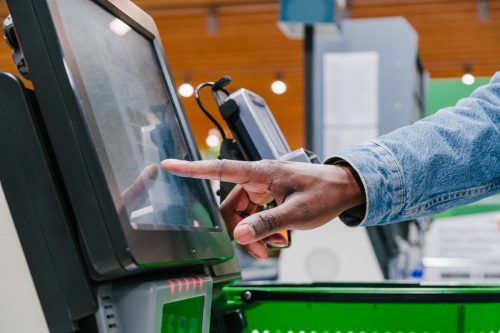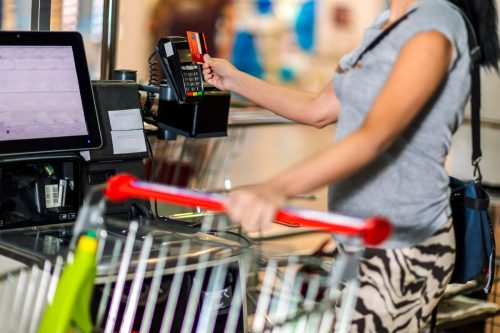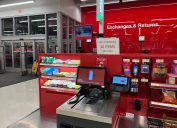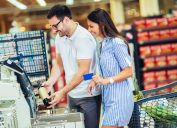How Self-Checkout Is Making You Spend More, New Study Reveals
Researchers say certain line designs can push shoppers into treating themselves.

Many of us already have some qualms when it comes to self-checkout. You usually still have to wait in line, and then you're forced to scan and bag everything yourself. On top of that, the machines are often temperamental and quick to call out an "unexpected item in the bagging area," which leaves you waiting even longer for a worker to come over and clear the kiosk so you can continue. But there may be other hidden downsides to this payment process that you weren't even aware of. New research shows that self-checkout is actually causing shoppers to spend more. Read on to find out how.
RELATED: Self-Checkouts Are Getting Item Limits—Here's How It Will Affect You.
Self-checkout has become the dominant checkout format for some retailers.

The rise of self-service checkout options has taken the world by storm over the past few years—so much so, in fact, that it's now the dominant checkout format for grocery stores, according to a study released earlier this year from VideoMining. The study indicated that self-checkout terminals accounted for 55 percent of all grocery transactions in 2022, and they also made up nearly half of all checkout registers.
Shoppers are also growing more accustomed to using self-checkout machines, as the usage of these kiosks in grocery stores has increased by 53 percent in five years.
"Retailers have been heavily investing in self-checkout technologies in an effort to improve the in-store shopping experience and reduce wait times, while also addressing the compounding business challenges around rising labor costs and labor shortages," researchers explained.
But now, a new study may make you think twice about using these machines.
RELATED: Walmart Worker Issues Warning to Shoppers About Self-Checkout.
A new study reveals that self-checkout can make shoppers spend more money.

More recent research on self-checkout machines could be bad news for those on a budget. For a new U.K.-based study, researchers with the Hershey Company spent "countless hours observing shoppers in self-checkout areas in different retail environments including small and large format, grocery, mass market and dollar," according to an Aug. 2023 release.
The researchers initially hypothesized that self-checkout machines make shoppers spend less in the store. The thought was that the increase in checkout speed would allow very little "forced dwell" time for shoppers. In other words, they believed consumers wouldn't be tempted to scope out other buying options while waiting to check out if a line never formed.
The study's results, however, "surprised" the researchers, who discovered that self-checkouts are sometimes having the opposite effect.
RELATED: Kroger Boycott Threats Grow Amid Self-Checkout Backlash.
Researchers say it comes down to line design.

But how can self-checkout lanes get shoppers to spend more money? According to the study, it all comes down to having the right line (or "queue" in the U.K.) design.
"We learned that in well-designed queues, shoppers want to dwell and treat themselves," Nicole Capes, Hershey's senior manager of transaction zones, and Kelsey Onorato, Hershey's manager of human insights, stated in their release. "An optimal queue also invites a sense of calm, allows for social justice and the ability to peruse the merchandise."
According to Hershey's study, well-designed lines are beneficial for retailers and shoppers alike.
"On the retail side, queues can increase front-end sales significantly; for shoppers, queues can add a feeling of organization by helping with navigation and giving shoppers something to focus on while waiting in line," they explained.
The company is helping retailers optimize their lines.

There are so many different styles of merchandise lines in self-checkout areas. As Hershey's researchers explained in their release, "Some twist and turn, while others are straight. Some have multiple vs. single-entry points for shoppers. Some queues are wide and short, and some are skinny and long."
But many retailers reportedly saw their front-end sales drop when they replaced cashier lanes with self-checkout machines—indicating that they weren't using the right designs.
Through their in-store research, Hershey's team identified six queue design principles that can help create a well-designed line and increase front-end sales. "The principles range from sight lines to the optimal shape and size," the researchers explained.
To help, Hershey's is now using these six principles from their study to partner with retailers to co-create and optimize lines. "Merchandising solutions at self-checkout can help retailers avoid losing sales," they noted.
RELATED: For more up-to-date information, sign up for our daily newsletter.





















